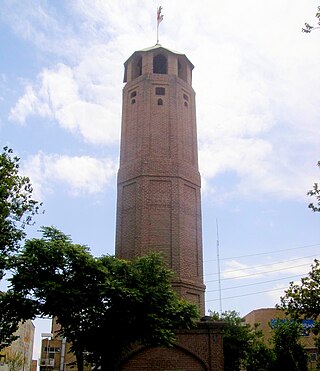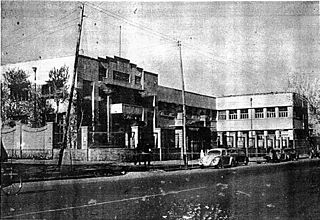The topic of this article may not meet Wikipedia's general notability guideline .(January 2024) |
Azerbaijan Square is the largest square in Tabriz. [1] The square is in the vicinity of Tabriz International Airport.
The topic of this article may not meet Wikipedia's general notability guideline .(January 2024) |
Azerbaijan Square is the largest square in Tabriz. [1] The square is in the vicinity of Tabriz International Airport.

Haji Mirza Hassan Tabrizi, famously known as Hassan Roshdieh, was an Iranian cleric, teacher, politician, and journalist. He introduced some modern teaching methods in Iran, especially in teaching the alphabet. These are still used to some degree in Iran's primary schools.

El Goli, also called Shah Goli is a large historic park in the south east region of Tabriz, Iran. One of its main features is its large artificial lake, measuring approximately 55.000 m2/592.015 ft square.

Azerbaijan Museum is the major archaeological and historical museum in Tabriz, in the northwest part of Iran. It was established in April 1958. The museum consists of three major halls, a side yard, office rooms and a library. It mostly contains objects discovered from excavations in Iranian Azerbaijan, also some artworks and sculptures of artists. Its library contains more than 2500 books, both handwritten and printed, about history, archaeology, art and Iranian culture.
Khaqani Park or Boostan Khaqani is a small park in Tabriz. The park is named after Khaqani Shirvani, who died in Tabriz.

The Amir Nezām House, or The Qajar Museum of Tabriz, is a building in the Sheshghelan district, Tabriz, Iran. This monument which since 2006 houses a museum dedicated to the Qajar dynasty (1781-1925), was built in the period of the Crown Prince Abbas Mirza (1789-1833). Because of persistent neglect over a long period of time, this building had come to be in such a bad state of disrepair that for a time it was seriously considered to demolish it and build a school in its place. Between 1993 and 2006 it has been subject of a renovation process and has been granted the National Heritage status.

The Tabriz Firefighting Tower is a historical tower located in Tabriz, Iran. The tower, standing at 23 meters high, was built in 1917. It was used to investigate fire related incidents inside the city. The city was constantly observed from this tower for any signs of smoke and fire. Following any visual evidence, the firemen were informed and sent to the fire incident location.
Museum of Ostad Bohtouni is a museum in Tabriz, north-western Iran. The museum is located in the Sheshghelan suburb of Tabriz.

The Constitution House of Tabriz, also known as Khaneh Mashrouteh, is a historical edifice located next to the Great Bazaar of Tabriz, on Motahari Ave in Tabriz, Iran. During the years which led to Constitutional Revolution and afterwards the house was used as a gathering place of the leaders, activists and sympathizers of the movement. Among them, the most famous people were Sattar khan, Bagher Khan, Seqat-ol-Eslam Tabrizi and Haji Mirza Aqa Farshi and the founder Haji Mehdi Kuzeh kanaani, himself a revolutionary activist and a well-reputed person of the time; who was named Abolmele, i.e. the father of the nation at the time. The two-story building was constructed in 1868 by Haj Vali Me'mar-e TabriziTABRIZArchived 2007-10-15 at the Wayback Machine.

Sheshghelan is one of the districts of Tabriz. Located at the city center, it is one of the oldest quarters of the city and contains several historical buildings, including Qari Bridge, Amir Nezam House, Seyed Hamzeh shrine. Museum of Ostad Bohtouni and Maqbaratoshoara are other points of interest in Sheshgelan.

Baron Avak is an old neighbourhood in the city center of Tabriz in northwestern Iran. The inhabitants of Baron Avak are mostly among the Iranian Armenian minority of Tabriz. The neighbourhood contains several historic and contemporary buildings and organizations dedicated to the Armenians of Tabriz, such as several churches, sportsclubs, gardens and schools. The name of the neighbourhood comes after Avak Avakian, who was the wealthy founder of the neighbourhood in nineteenth century.

The Quri River or Quru Chay or Quri Chay is a river in East Azerbaijan province of Iran, in the endorheic basin of Lake Urmia. It originates in the mountains east of Tabriz and joins the Aji Chay just northeast of central Tabriz. The river divides Tabriz into northern and southern parts which are connected to each other by several bridges. The two Ghari Bridges, beside each other, are the most famous and historic of the bridges over the river. The Sangi Bridge is also of historic interest.

The Aji Chay or Talkheh Rud is a river in Azerbaijan region of Iran. Most of it is in the East Azerbaijan Province.
Pol Sangi is a bridge in Tabriz, Iran, over the Quri River. The stone bridge belongs to the Qajar period and is located in Chaiknar, in front of the Pol Sangi Mosque. The bridge was registered as a national monument of Iran on August 1, 2005 with the registration number 12438.
Baghmisheh gate, also transliterated as Baghmasha, is an old gate in the Bazaar suburb of Tabriz, north-western Iran.

The East-Azerbaijan Provincial Palace is the main office for Iran's East-Azerbaijan provincial governor in downtown Tabriz. The history of the palace goes back to the Safavid and Zand dynasties, when it was named Aali Qapou. The original construction of the palace was supervised by Najaf Qoli Khan for the Safavid kings, when Tabriz was the capital of Iran. During the Qajar era, Aali Qapu served as the residence for the crown prince of Iran. It was reconstructed and repaired under Naser al-Din Shah, during which its name was changed to Shams ol-Emareh. Since the Iranian Constitutional Revolution, the palace has been used as the provincial governorship office.

Aji Chy Bridge is a historic bridge in Northwest of Tabriz on the Aji Chay river. This bridge was used to connect Tabriz to the Northwestern parts of Iranian Azerbaijan and a major element on route to connect rest of country to Turkey and Russia. In this function it was a major element in connecting East and Western parts of the Silk road. The bridge has been restored and damaged numerous times during the course of history either by natural disasters or during the wars happened in the region. The latest major reconstruction of the bridge was performed in the 19th century during Abbas Mirza's governorship by architect Hadj-Seyed-Hossein Tajer. The bridge includes 16 spans with an overall length of 105 meters and width of 5 meters. Due to several times of restoration and reconstruction the bridge doesn't have a uniform architecture. Three spans out of 16 are semi circular shape while rest of the spans are in zig zag shape. Recently the restoration of the bridge was performed by Iranian Organization of Cultural Heritages and registered in Iranian national heritages with number 2516.
Maralan is a historic district in the southeastern part of Tabriz, the biggest city in Iranian Azerbaijan. To the north lies the Khiyavan district, and to the west, Maralan shares an order with the Nobar district. The Azadi Blvd. divides Maralan district into a northern and southern part.

Mansur High school or Taleqani High School (in South Azerbaijani: منصور مدرسهسی, in Persian: (دبیرستان منصور is an old high school located in city center of Tabriz. A reconstruction of the main building started in August, 2012.

Marzdaran Stadium of Tabriz is a stadium in Tabriz, Iran. It was previously used primarily for football matches and served as the home stadium of Shahrdari Tabriz. Currently it is used as a football academy and training grounds for Machine Sazi. The stadium holds 5,000 people and was built in 2014 by Municipality of Tabriz.
Khiyavan is one of the oldest districts of Tabriz. Khiyavan is restricted to Meydan River, Maralan district and Azadi Blvd. During the constitutional revolution of Iran, Khiyavan was under the command of Baqir Khan and had an important role in the victory of the revolution.
38°06′46″N46°16′11″E / 38.112789°N 46.269789°E